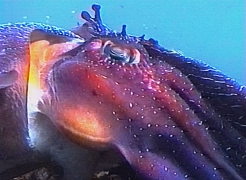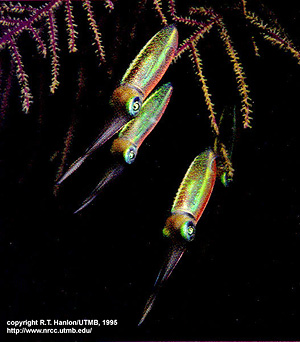
 |
| Home | What's New? | Cephalopod Species | Cephalopod Articles | Lessons | Bookstore | Resources | About TCP | FAQs |
The Colourful World of Cephalopods - Cephalopod body patterning II<< Cephalopod Articles | by Within the skin of a cephalopod, there are layers of colour producing cells that work together to give different patterns. These patterns are built up by overlaying different types of colour-producing cells that each contribute unique elements to a pattern. Within the skin of a cephalopod, there are layers of colour producing cells that work together to give different patterns. These patterns are built up by overlaying different types of colour-producing cells that each contribute unique elements to a pattern.
Chromatophores are found directly under the skin's surface. Each chromatophore is made of an elastic saccule (small sac), its resident pigment granules and 15-25 radial muscles. The radial muscles surround and are attached to the sacculus. When the muscles contract, they expand the sacclus making the coloured pigment granules more apparent to the observer. When the muscles relax, the elastic nature of the sacculus causes it to contract, diminishing the colour seen by the observer (See the book, Cephalopod Behavior, and Packard's chapter for more information).  The three common colours for pigment granules are black-brown, red-orange and orange-yellow. Depending on the species, these colours can vary in range and intensity. For example, the Australian giant cuttlefish (Sepia apama), which lives in relatively shallow (around 30 m), well lit, reef environments shows vivid colour displays. This is possible because of its wide range of chromatic pigments. Not bad for the cousin of a slug! Bathypolypus arcticus, a deep-sea octopus that isn't typically exposed to much light and lives on sand, displays more subdued colour patterns. Its pigment repertoire is limited to brown and red. The three common colours for pigment granules are black-brown, red-orange and orange-yellow. Depending on the species, these colours can vary in range and intensity. For example, the Australian giant cuttlefish (Sepia apama), which lives in relatively shallow (around 30 m), well lit, reef environments shows vivid colour displays. This is possible because of its wide range of chromatic pigments. Not bad for the cousin of a slug! Bathypolypus arcticus, a deep-sea octopus that isn't typically exposed to much light and lives on sand, displays more subdued colour patterns. Its pigment repertoire is limited to brown and red.
Chromatophores are the quickest and most obvious colour-changing mechanism in the near-shore cephalopods, and have been the most intensely studied. Leucophores and iridophores, however, also play a role in dermal patterning. They both reflect light to produce colours that glow. Leucophores are found in cuttlefish, some squid and some octopuses. They are found in the lowest pigment layer. Reflecting ambient light, they are primarily used in camouflage. Iridophores produce iridescent colours that can range from blue to gold. They lie between the chromatophore and leucophore layers in the skin. Chromatophores, iridophores and leucophores often work together to make patterns. Here you can see the glowing colours of underlying reflector cells (leucophores and iridophores) being blocked out in places by overlying chromatophores. All types of cells are needed in order to produce this pattern. In addition to being able to change skin colour, cephalopods are also able to change skin texture. They can go from smooth to spiky in milliseconds by contracting special muscles in their skin. The bumps are like goosebumps, but they are not because of cold, and can be quite large relative to the animal's body. They are called papillae. Papillae can be subdued, or can be elaborate like the ones on Sepia apama, the Australian giant cuttlefish (see above). For information on how cephalopods control their skin colour and texture, click here. To go back to page 1, click here.
| ||||||
| Home | What's New? | Cephalopod Species | Cephalopod Articles | Lessons | Resources | About TCP | FAQs | Site Map | |
 |
The Cephalopod Page (TCP), © Copyright 1995-2026, was created and is maintained by Dr. James B. Wood, Associate Director of the Waikiki Aquarium which is part of the University of Hawaii. Please see the FAQs page for cephalopod questions, Marine Invertebrates of Bermuda for information on other invertebrates, and MarineBio.org and the Census of Marine Life for general information on marine biology. |